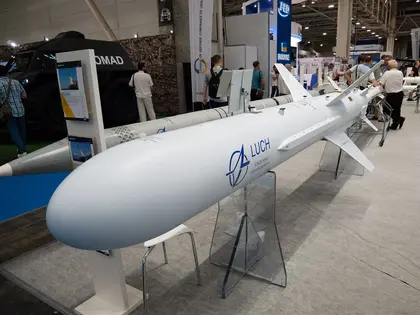Ukrainian military technicians are working on an updated version of the killer missile that sank the Russian navy cruiser Moskva, once the most powerful warship on the Black Sea, news reports said.
Deputy Minister of Defense Lt. Gen. Ivan Havrylyuk said military scientists have kicked off research and development work in a formerly secret project intended to field a missile called “Long Neptune.”
JOIN US ON TELEGRAM
Follow our coverage of the war on the @Kyivpost_official.
“We are currently working on the so-called Long Neptune, a new modification of the missile for the Neptune complex,” said Gen. Havrylyuk in an interview with ArmyInform. He said the new missile’s specs and improvements are military secrets, as is the progress of the development.
Kyiv Post requested further details concerning Havrylyuk’s statement and the state of the Long Neptune development, from the Press Office of the Ministry of Defense and the Neptune missile manufacturer, joint-stock company Ukroboronprom (Ukrainian Defense Industry). Both declined to comment, citing a need to protect state secrets.
In April, an anonymous source from the Ukrainian Defense Department informed War Zone about ongoing efforts to modify the Neptune anti-ship missile for ground targets. Havrylyuk’s comment to ArmyInform marked the first time a Ukrainian official had confirmed the Neptune modification effort was actually in progress and made public the name of the new weapon.

FPV Drones Effective in 20-40% of Ukrainian and Russian Strikes, Commander Says
Ukrainian news platforms reported the destruction of Russia’s top tier “Triumph” missile system in occupied Crimea on Aug. 23, by a “domestically developed” missile system whose specific type was not identified by official sources.
Secretary of the National Security and Defense Council of Ukraine, Oleksiy Danilov, at the time stated on Twitter/X that a new Ukrainian missile destroyed a Russian S-400 Triumph launcher in Olenivka, Crimea.
In the wake of that strike, Ukrainian journalist Yuriy Butusov suggested an anti-ship Neptune modified for ground operations may have been responsible.
The Neptune missile is a domestically developed weapon first fielded in 2021. The most spectacular wartime use of the Neptune to date took place on April 14, 2022, when a pair of Neptunes struck and sunk the flagship of Russia’s Black Sea Fleet in an engagement near Zmiinyi Island.
In recent reports, Ukrainian defense-linked media, including Defense Express and Militarnyi, suggested that Ukraine was likely attempting to reconfigure the R-360 Neptune missile to strike ground targets. Most likely, the updated Neptune missile will be fired from the same truck-mounted launcher as before, those reports said.
The projected range for the new, modified, surface-to-surface Neptune missile is expected, per those reports, to reach 400 km, an increase from the 300 km range of the anti-ship version.
The weapon’s warhead will more than double in power increasing from an explosives-carried weight of 150 kg. to 350 kg, but those specs are still on the drawing board, the reports said.
Defense Express speculates that funding for the “Long Neptune” project, and current ongoing modifications, will come from a Hr.175 billion ($4.8 billion) line item earmarked for “missile weapons and ammunition” in Ukraine’s state budget next year.
According to War Zone, the new Neptune will use a GPS satellite guidance system directing the missile to a predetermined target, in contrast to the anti-ship version, which uses inertial guidance to fly to the general area of a ship, after which a radar aboard the missile switches on to seek and help the weapon home in on the ship.
In the surface-to-surface version of the Neptune, War Zone reported, once the GPS system flies the missile close to a ground target, in the final flight stage an infrared homing system would switch on to scan the ground below it and help the missile home in on objects matching a pre-programmed target profile.
The land-based Neptune would be able to abort its attack if the identified objects observed by the infrared homing system did not match the specified pre-programmed target profile, the report said.
Militarnyi highlighted that while the Neptune anti-missile defense system is initially designed for a maximum flight distance of 360 kilometers, increasing its range is relatively easy.
The missile is propelled by an MC-400 kerosene-fueled turbojet aircraft engine, so the flight range can be extended by enlarging the internal fuel tanks or adding an external tank, the article said.
The military journal Bulgarianmilitary.com in a recent article highlighted the challenge of converting an anti-ship cruise missile for use against ground targets. Such a conversion would not be easy, but Ukraine has the technical capacity to do it, if sufficient resources were available, the article said.
You can also highlight the text and press Ctrl + Enter






